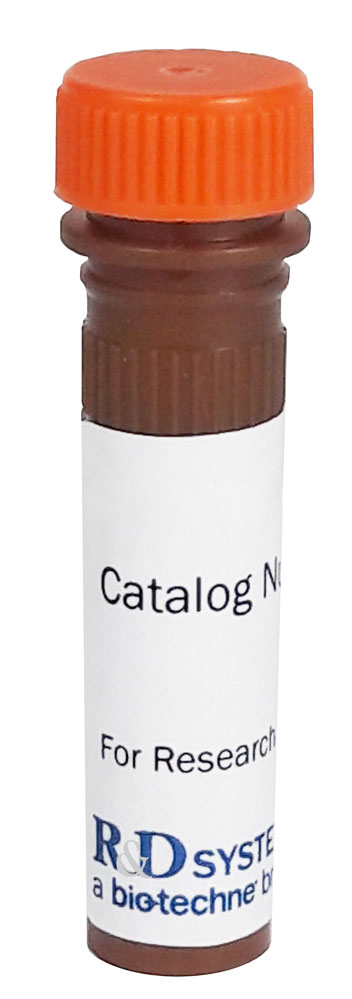Mouse KLRG1 Alexa Fluor® 750-conjugated Antibody
Mouse KLRG1 Alexa Fluor® 750-conjugated Antibody Summary
Glu57-Tyr188
Accession # O88713
Applications
Please Note: Optimal dilutions should be determined by each laboratory for each application. General Protocols are available in the Technical Information section on our website.
Reconstitution Calculator
Preparation and Storage
Background: KLRG1
KLRG1 (Killer cell Lectin‑like Receptor G1), also called MAFA (Mast cell Function Associated), is an inhibitory type II transmembrane glycoprotein of the C‑type lectin family, designated CLEC15A (1). Mature mouse KLRG1 consists of a 33 amino acid (aa) cytoplasmic domain with one Immunoreceptor Tyrosine‑based Inhibitory Motif (ITIM), a 23 aa transmembrane segment, and a 132 aa extracellular domain (ECD) with one C‑type lectin domain (CTLD) (2). Within the ECD, mouse KLRG1 shares 57% and 80% aa sequence identity with human and rat KLRG1, respectively. Alternate splicing generates additional isoforms of mouse KLRG1 that lack either the CTLD or the CTLD, transmembrane segment, and a portion of the cytoplasmic domain (3). KLRG1 is expressed as a 30 ‑ 40 kDa N‑glycosylated molecule that forms disulfide‑linked homodimers, trimers, and tetramers (4, 5). It is expressed on subpopulations of CD8+, CD4+, regulatory, and gamma/delta T cells as well as on NK cells (2, 4, 6 ‑ 8). KLRG1 is expressed on T cells found in cord blood, but it is down‑regulated postnatally and is subsequently re‑expressed on antigen‑exposed T cells (7, 9). It is expressed by a greater proportion of CD8+ T cells in the elderly and by virus‑specific CD8+ T cells during chronic virus infection (10 ‑ 12). KLRG1 binds to E-, N-, and R-Cadherins, triggering ITIM‑dependent KLRG1 signaling and inhibition of T cell activation (5, 13, 14). The response is bi‑directional, as KLRG1 binding to E‑Cadherin on dendritic cells (DC) can induce an anti‑inflammatory DC phenotype (increased IL‑10 production and decreased IL‑6 and TNF‑ alpha production) (15).
- Henson, S.M. and A.N. Akbar (2009) Age 31:285.
- Hanke, T. et al. (1998) Eur. J. Immunol. 28:4409.
- Voehringer, D. et al. (2001) Immunogenetics 52:206.
- Corral, L. et al. (2000) Eur. J. Immunol. 30:920.
- Rosshart, S. et al. (2008) Eur. J. Immunol. 38:3354.
- Voehringer, D. et al. (2002) Blood 100:3698.
- Beyersdorf, N. et al. (2007) Eur. J. Immunol. 37:3445.
- Eberl, M. et al. (2005) J. Leukoc. Biol. 77:67.
- Marcolino, I. et al. (2004) Eur. J. Immunol. 34:2672.
- Ouyang, Q. et al. (2003) Exp. Gerontol. 38:911.
- Thimme, R. et al. (2005) J. Virol. 79:12112.
- Cush, S.S. and E. Flano (2011) J. Immunol. 186:4051.
- Ito, M. et al. (2006) J. Exp. Med. 203:289.
- Tessmer, M.S. et al. (2007) Int. Immunol. 19:391.
- Banh, C. et al. (2009) Blood 114:5299.
Product Datasheets
Product Specific Notices
This product is provided under an agreement between Life Technologies Corporation and R&D Systems, Inc, and the manufacture, use, sale or import of this product is subject to one or more US patents and corresponding non-US equivalents, owned by Life Technologies Corporation and its affiliates. The purchase of this product conveys to the buyer the non-transferable right to use the purchased amount of the product and components of the product only in research conducted by the buyer (whether the buyer is an academic or for-profit entity). The sale of this product is expressly conditioned on the buyer not using the product or its components (1) in manufacturing; (2) to provide a service, information, or data to an unaffiliated third party for payment; (3) for therapeutic, diagnostic or prophylactic purposes; (4) to resell, sell, or otherwise transfer this product or its components to any third party, or for any other commercial purpose. Life Technologies Corporation will not assert a claim against the buyer of the infringement of the above patents based on the manufacture, use or sale of a commercial product developed in research by the buyer in which this product or its components was employed, provided that neither this product nor any of its components was used in the manufacture of such product. For information on purchasing a license to this product for purposes other than research, contact Life Technologies Corporation, Cell Analysis Business Unit, Business Development, 29851 Willow Creek Road, Eugene, OR 97402, Tel: (541) 465-8300. Fax: (541) 335-0354.
FAQs
No product specific FAQs exist for this product, however you may
View all Antibody FAQsReviews for Mouse KLRG1 Alexa Fluor® 750-conjugated Antibody
There are currently no reviews for this product. Be the first to review Mouse KLRG1 Alexa Fluor® 750-conjugated Antibody and earn rewards!
Have you used Mouse KLRG1 Alexa Fluor® 750-conjugated Antibody?
Submit a review and receive an Amazon gift card.
$25/€18/£15/$25CAN/¥75 Yuan/¥2500 Yen for a review with an image
$10/€7/£6/$10 CAD/¥70 Yuan/¥1110 Yen for a review without an image



